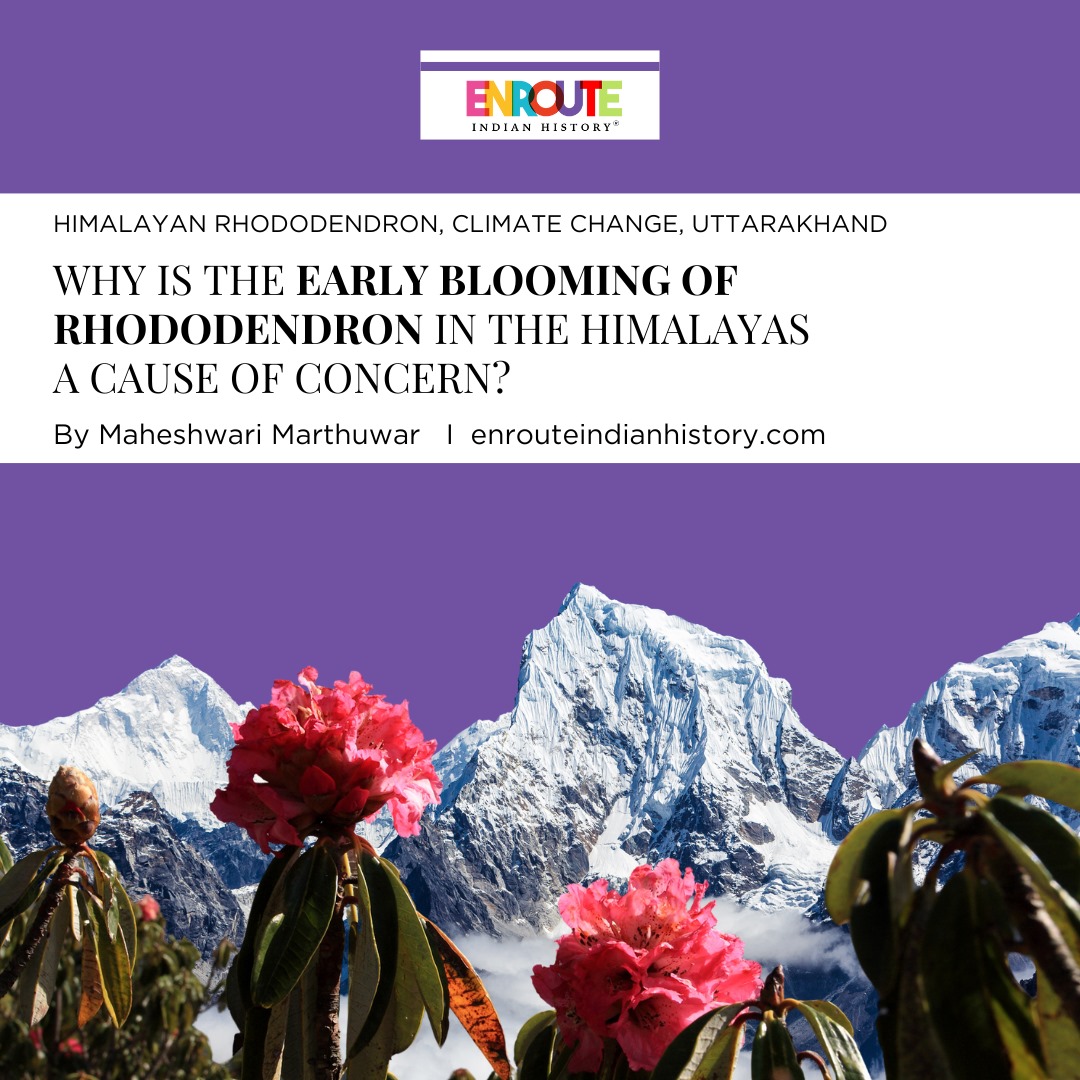Why is the early blooming of Rohendedron in the Himalayas a cause of concern?
- EIH User
- May 15, 2024

With the changing climate patterns around the world, the impact on flora and fauna is becoming more evident. One such example of this is the early blooming of the Himalayan rhododendron, a beautiful flower species native to the high altitudes of the Himalayas. In the heart of the majestic Himalayas, where towering peaks pierce the heavens and vibrant biodiversity thrives, a delicate flower serves as a poignant indicator of the profound impacts of climate change. The Himalayan rhododendron (Rhododendron arboreum), renowned for its captivating beauty and ecological significance, has recently exhibited an alarming trend : early blooming. This phenomenon, observed in various regions across the Himalayan range, is a harbinger of the far-reaching consequences of rising global temperatures. As the climate warms, the intricate balance of nature is disrupted, leading to shifts in plant phenology – the timing of biological events such as flowering. The early blooming of the Himalayan rhododendron serves as a stark reminder of the urgent need to address climate change and mitigate its effects on vulnerable ecosystems. In this article, we delve into the implications of early rhododendron blooming, exploring its ecological consequences and the wider implications for biodiversity conservation and the well-being of mountain communities. By examining the interplay between climate change and this sentinel species, we aim to shed light on the pressing challenges facing our planet and inspire action to safeguard the fragile tapestry of life.

Buransh in Uttarakhand Valley
The Himalayan Rhododendron: A Natural Beauty
The Himalayan Rhododendron is a breathtaking flower that captures the essence of the majestic Himalayan region. With its vibrant colors and delicate petals, it stands out as a natural beauty that has captivated both locals and visitors alike for centuries. Rhododendron arboretum, is a small evergreen tree locally known as Buransh Tree. Blooming in March and April when the snow has melted and the hills are warming up. Rhododendron, meaning “red trees”, is found mainly in Asia. It is the national flower of Nepal and the state tree of Sikkim and Uttarakhand in India. The pink rhododendron is the state flower of Himachal Pradesh. These magnificent flowers are found in abundance throughout the Himalayas, adorning the slopes and valleys with their vibrant hues of red, pink, purple, and white. Their sheer abundance and diversity make the Himalayan Rhododendron a true symbol of natural splendor that adds to the allure of this enchanting landscape.
The Himalayan Rhododendron is known for its distinct physical characteristics. Its evergreen leaves, leathery in texture, provide a lush green backdrop to the vibrant blossoms. The flowers themselves come in various shapes, from trumpet-like to bell-shaped, exuding an air of elegance and grace. In addition to its visual appeal, the Himalayan Rhododendron holds immense ecological importance. The dense forests of these flowers serve as vital habitats for numerous animal and bird species, ensuring the delicate balance of the regional ecosystem. The nectar-rich flowers attract a wide variety of pollinators, including bees and butterflies, contributing to the biodiversity of the region.
Furthermore, the Himalayan Rhododendron holds cultural significance in the local communities. Its blooms often coincide with traditional festivals and celebrations, where it is used for religious rituals, decorations, and even in traditional medicines. This flower is deeply woven into the fabric of the Himalayan culture, representing beauty, resilience, and harmony with nature. As climate change continues to impact the Himalayan region, the future of the Himalayan Rhododendron is at stake. The early blooming of these flowers serves as a sensitive indicator of ecological shifts caused by rising temperatures and altered precipitation patterns. By understanding and cherishing the beauty and importance of the Himalayan Rhododendron, we can raise awareness about the need for sustainable practices and conservation efforts to protect this natural treasure for generations to come.
Climate Change and Its Impacts on the Himalayan Region
Climate change poses significant challenges for the Himalayan region, affecting its delicate ecosystem and biodiversity. The increasing temperatures and altered precipitation patterns have far-reaching consequences, including the earlier blooming of the Himalayan Rhododendron. This iconic flower serves as an indicator of the ecological shifts occurring due to climate change. The rising temperatures in the Himalayan region have accelerated the snowmelt, disrupting the timing of the seasonal cycles. As a result, the Rhododendrons, which typically bloom in the spring, are now flowering earlier than usual. This phenomenon not only impacts the aesthetic appeal of the region but also has ecological implications. The altered precipitation patterns further exacerbate the impacts of climate change. Changes in rainfall and snowfall can disrupt the delicate balance of water availability in the region, affecting the growth and reproductive cycles of the Rhododendron. These changes in water availability influence the timing and duration of blooming, potentially leading to the loss of pollinators and biodiversity within the Himalayan ecosystem. Moreover, climate change in the Himalayan region has broader societal and economic implications. The melting glaciers, erratic weather patterns, and increased frequency of extreme events pose serious threats to local communities, who depend on the region’s resources for their livelihoods. Loss in Medicinal Potency of the Flower, Disrupted nectar production, Economic Repercussions and Affect on Tourism. These impacts necessitate effective adaptation strategies and sustainable development practices to mitigate the adverse effects of climate change.

Conservation Action Plan for Rhododendrons
Protecting the Himalayan Region
Sudipto Chatterjee leads the Biodiversity and Conservation Programme for the InsPIRE Network for Environment, focusing on addressing environmental challenges in India, including biodiversity loss and climate change. The decline of Rhododendron plants in India’s Eastern Himalayas is primarily due to habitat destruction, unplanned development, and over-exploitation, putting nearly half of the species at risk of extinction. Sudipto and his team are developing a Conservation Action Plan for Rhododendrons to consolidate data and influence policy for the protection of these plants at both landscape and regional levels. With the help of local communities, Sudipto aims to establish a network of conservation areas for India’s Rhododendron diversity and promote sustainable energy sources like solar power to reduce over-exploitation of these plants. In 2009, WFN provided financial support to Sudipto and his team with an Associate Award of £10,000 for a year of project funding.
The early blooming of the Himalayan Rhododendron serves as a clarion call for action. It highlights the urgent need to address climate change and protect the fragile ecosystems of the region. Efforts such as raising awareness about the impacts of climate change, promoting sustainable tourism practices, and implementing conservation initiatives can contribute to safeguarding the Himalayan biodiversity and ensuring the long-term sustainability of this majestic landscape.

The folk festival Phuldei in a traditional manner. Children carrying baskets of flowers prayed for prosperity at the doorsteps of their homes. Since morning the children started celebrating Phul Dei festival.
Early Blooming of the Himalayan Rhododendron: A Telltale Sign
The blooming, celebrated as flower day (phool sankranti) across the Himalayan state, usually heralds the onset of spring and marks a special day for the locals. The month-long Phool Dei is celebrated in mid-March. Children go house to house in the village and place flowers on the gate or entrance of the house. That the flowers bloomed so early due to an unusually warm spell, two-three months before they typically do, could be due to climate change, that has caught the attention of researchers and scientists studying climate change. Through scientific research and studies, it has become evident that the early blooming of this iconic flower is not just a coincidence, but rather a telltale sign of the impact of climate change on the Himalayan region.
The Himalayan Rhododendron, with its vibrant blooms and majestic presence, has long been admired by locals and visitors alike. However, the timing of its blooming has shifted, with flowers now appearing earlier in the year than before. This shift has raised concerns among scientists, who see it as a clear indication of the changing climate and its impact on the delicate ecosystems of the region.
Rhododendron arboretum, a small evergreen tree locally known as buransh, is flowering early because temperatures are rising in the hills. Rhododendron needs a temperature of 15-20 degree Celsius to bloom, which is the average temperature in the months of March and April in middle and higher reaches of the Himalayas. But, for the last few years, the winter months have recorded high temperatures leading to the early flowering. Research has shown that rising temperatures and altered precipitation patterns resulting from climate change play a significant role in the early blooming of the Himalayan Rhododendron. Warmer temperatures initiate the blooming process earlier, disrupting the natural timing that has been followed for generations. This phenomenon is not limited to a few isolated incidents but is now observed across a wide range of locations in the Himalayan region.


Buransh Tea And Juice
They are a source of nectar for pollinators, which in turn affects the reproduction of various plant species. An untimely bloom can disrupt the synchrony between the flowers and their pollinators, potentially leading to a decline in both. Moreover, the rhododendron is deeply intertwined with the local culture and economy. The flower’s Buransh Tea or Juice is a traditional refreshment, and its early bloom could affect its availability and quality. Additionally, The rhododendron holds significant medicinal value. It contains potassium, calcium, iron, and vitamin C, and is used to treat ailments like mountain sickness and It is also considered beneficial to stop excessive bleeding in women during menstruation. Local delicacies like the Buransh chutney are said to be rich in antioxidant, anti-inflammatory, and anti-diabetic properties. The early bloom could potentially reduce the medicinal potency of the flowers, which is a direct concern for the health and well-being of the local population. The early flowering of rhododendrons also poses a risk to the plants themselves. Blooming before the winter has fully passed means the flowers may face frost and cold snaps that they would typically avoid. This could lead to a decrease in their survival rates and long-term changes in their distribution across the hills.
The Premature Rhododendron is not just a concern for botanists or environmentalists; it is a warning sign for all of us. The Rhododendron acts as a barometer, indicating the ecological shifts and disruptions caused by climate change. Its early blooming highlights the urgency to address the challenges posed by rising temperatures and changing weather patterns.
To further understand the implications of this early blooming, ongoing research and monitoring efforts are being conducted. Scientists are rigorously studying the blooming patterns of the Himalayan Rhododendron, collecting data that provides valuable insights into the impact of climate change on the region’s biodiversity and ecosystems. This research will help inform conservation efforts and guide policymakers in implementing measures to mitigate the effects of climate change.
Buransh-based products like juices, squashes, and other edibles derived from Buransh flowers are a common sight in grocery shops and roadsides across the hill state for tourists. With the quantity and quality of the blossoms being affected, the economic repercussions of such disruptions could exacerbate existing challenges faced by communities in the region. With the early bloom, important festivities are also disrupted like the annual Buransh Mahotsav celebrated in Kausani on the onset of spring every year with great zeal. Residents are skeptical that there may be an adverse impact on tourism as well.
The early blooming of the Himalayan Rhododendron serves as a tangible and visible sign of the threats posed by climate change. Its shifting blooming patterns act as an alarm bell, reminding us of the urgent need to take action to protect our natural environment. By studying and understanding the relationship between the early blooming of the Rhododendron and climate change, we can work towards a more sustainable future for the Himalayan region and beyond.
The early blooming of the Himalayan Rhododendron serves as a compelling indicator of the ecological impacts of climate change. As temperatures rise and precipitation patterns shift in the Himalayan region, this iconic flower has begun to bloom earlier than usual, disrupting its natural life cycle. Monitoring this phenomenon is crucial in order to understand the broader implications of climate change on the fragile ecosystem of the Himalayas. By studying the early blooming patterns of the Rhododendron, scientists and researchers can gain valuable insights into the effects of warming temperatures and altered weather patterns on plant species. It is of utmost importance that we raise awareness about the significance of this early blooming event and take proactive measures to conserve the Himalayan Rhododendron and its natural habitat. Only through increased awareness and collective efforts can we mitigate the effects of climate change and preserve the unique biodiversity of the region for future generations.
Reference
- Avikal Thapliyal, Phooldei- Flowers are flowers from the doorstep of power to the doorstep of villages, Article By Avikal Uttarakhand, 14th March 2023.
- Chatterjee Sudipto, Sudipto Chatterjee: An Action Plan For Conservation Of Wild Rhododendrons, Eastern Himalayas, Article Access 10th May 2024.
- Dayanidhi, Phul Dei festival of Uttarakhand: Which indicates that man cannot exist without nature, Article By Down To Earth, 15th March 2023.
- Debjyoti Bhattacharyya, Rhododendron Habitats in India, January 2018.
- Kohli Diya, Red alert: The Himalayas are blooming with rhododendron, Article By Condé Nast Traveller India, 30th March 2022.
- Nidhi Jamwal, Himalayan Rhododendron flowers are blooming in winter instead of spring. Is climate change to blame?, Article By IndiaSpend.com, 18th February 2018.
- Premature blooming alters buransh flower benefits, Article By Carbon Impact, 28th March 2024.
- Sailesh Ranjitkar, Flowering phenology of tree rhododendron along an elevation gradient in two sites in the Eastern Himalayas, International Journal of Biometeorology, DOI:10.1007/s00484-012-0548-4, March 2013.
- Shweta Sengar, Why Early Blooming Of Rhododendrons Is A Bad News For Bumble-bees & Butterflies In Himalayas, Article By Indiatimes, 13th April 2023.
- Why The Blooming Of This Flower In Uttarakhand Is A Cause Of Concern, Article By Times Of India, 7th May 2024.
Why has premature blooming of this flower raised alarm in Uttarakhand’s hills, what are its implications?, Article By First Post, 4th May 2024.



















